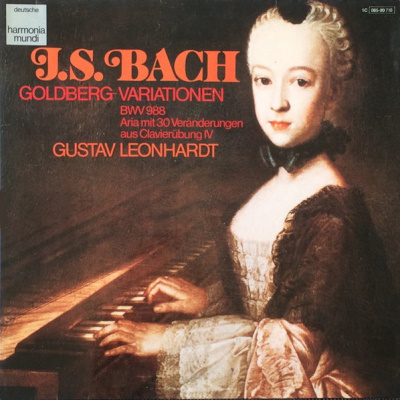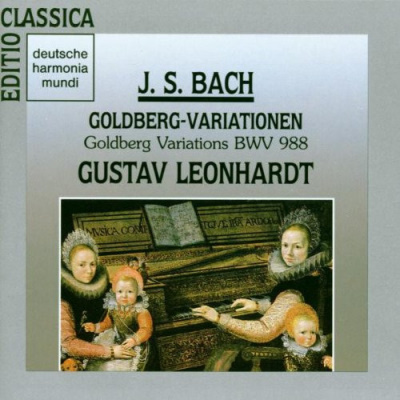 |
|
1 LP -
1C 065-99 710 - (p) 1978
|
 |
| 1 CD -
GD 77149 - (c) 1990 |
|
GOLDBERG
VARIATIONEN
|
|
|
|
|
|
|
|
| Johann Sebastian
BACH (1685-1750) |
Aria
mit verschiedenen Veränderungen vors
Clavicimbal mit 2 Manualen
(Goldberg-Variationen), BWV 988 |
|
47' 19" |
|
|
- Aria
|
2' 29" |
|
A1 |
|
- Variatio
1, a 1 Clav.
|
1' 33" |
|
A2 |
|
- Variatio 2, a 1 Clav.
|
1' 04" |
|
A3 |
|
- Variatio
3, a 1 Clav. - Canone
all'Unisono
|
1' 00" |
|
A4 |
|
- Variatio
4, a 1 Clav. |
0' 34" |
|
A5 |
|
- Variatio 5, a 1 ovvero 2 Clav.
|
1' 00" |
|
A6 |
|
- Variatio 6, a 1 Clav. - Canone
alla Seconda
|
1' 00" |
|
A7 |
|
- Variatio
7, a 1 ovvero Clav. - Al
tempo di Giga
|
1'
04"
|
|
A8 |
|
- Variatio
8, a 2 Clav. |
1' 18" |
|
A9 |
|
- Variatio
9, a 1 Clav. - Canone alla
Terza
|
1' 10" |
|
A10 |
|
- Variatio
10, a 1 Clav. - Fughetta
|
0' 52" |
|
A11 |
|
- Variatio
11, a 2 Clav. |
1' 25" |
|
A12 |
|
- Variatio
12, Canone alla Quarta |
1' 53" |
|
A13 |
|
- Variatio 13, a 2 Clav.
|
2' 38" |
|
A14 |
|
- Variatio 14, a 2 Clav.
|
1' 20" |
|
A15 |
|
- Variatio 15, a 1 Clav. - Canone
alla Quinta,
Andante
|
2' 50" |
|
A16 |
|
- Variatio
16, a 1 Clav. - Ouverture
|
1' 26" |
|
B1 |
|
- Variatio 17, a 2 Clav.
|
1' 02" |
|
B2 |
|
- Variatio
18, a 1 Clav. - Canone alla
Sesta
|
0' 44" |
|
B3 |
|
- Variatio
19, a 1 Clav. |
0' 58" |
|
B4 |
|
- Variatio 20, a 2 Clav.
|
1' 14" |
|
B5 |
|
- Variatio
21, Canone alla Settima |
1' 55" |
|
B6 |
|
- Variatio
22, a 1 Clav. - Alla breve
|
0' 46" |
|
B7 |
|
- Variatio
23, a 2 Clav. |
1' 20" |
|
B8 |
|
- Variatio
24, a 1 Clav. - Canone
all'Ottava
|
1' 53" |
|
B9 |
|
- Variatio
25, a 2 Clav. - Adagio
|
4' 07" |
|
B10 |
|
- Variatio
26, a 2 Clav. |
1' 13" |
|
B11 |
|
- Variatio
27, a 2 Clav. - Canone alla
Nona
|
0' 57" |
|
B12 |
|
- Variatio
28, a 2 Clav. |
1' 33" |
|
B13 |
|
- Variatio
29, a 1 ovvero 2 Clav. |
1' 11" |
|
B14 |
|
- Variatio
30, a 1 Clav. - Quodlibet
|
1' 06" |
|
B15 |
|
- Aria da
capo
|
1' 11" |
|
B16 |
|
|
|
|
|
Gustav LEONHARDT,
Cembalo (William Dowd, Paris
1975, nach Blanchet, Paris um
1730)
Stimmung: ein Halbton unter
Normalstimmung
|
|
|
|
|
|
Luogo
e data di registrazione |
|
Kirche Haarlem
(Holland) - aprile 1976
|
|
|
Registrazione: live
/ studio |
|
studio |
|
|
Recording
Supervision |
|
Dr. Th. Gallia | P.
Dery
|
|
|
Engineer |
|
Sonart
|
|
|
Prima Edizione LP |
|
Harmonia Mundi (EMI
Electrola) | 1C 065-99 710 | 1 LP
- durata 47' 19" | (p) 1978
|
|
|
Edizione CD |
|
Deutsche
Harmonia Mundi | LC 0761 |
GD 77149 | 1 CD - durata 47'
19" | (c) 1990 | ADD
|
|
|
Cover Art
|
|
Clavichordspielerin,
Unbek, süddeutscher Meister 18.
Jhd. Mit freundlicher Gebehmigung
von: Archir für Kunst und
Geschichte.
|
|
|
Note |
|
- |
|
|
|
|
Not too much
credence should be attached
to the story initially
reported in Johann Nikolaus
Forkel's 1802 biography of
Bach, that the Goldberg
Variations were written to
the commission of Count
Keyserlingk. In all
probability Bach presented
his noble sponsor with a
copy of the newly printed
work on his visit to Dresden
in November 1741, and it is
certain that Johann Gottlieb
Goldberg (1727-56), the
highly gifted pupil of J. S.
and W. F. Bach, and
Keyserlingk's
harpsichordist, often played
the work to his master -
probably in reality to while
away the latter's sleepless
nights. But there is no
trace of a formal dedication
to the Count on the title
page of the 1741 printed
edition, as the nieties of
18th century manners would
certainly have demanded.
Furthermore, it is more than
doubtful wheter Bach could
have had in mind the
capacities of the then only
13 year old Goldberg when he
began to compose the work,
in 1740 at the latest. It is
much more likely that this
set of variations, like the
three preceding parts of the
"Clavier-Übunh", were
written at Bach's own
initiative. The monumental
series of "clavier
exercises", representing the
most important types of
keyboard music in exemplary
compositions, was destined
to receive a cyclically
closed major work as its
crown and conclusion.
Yhis closing part of the
Clavierübung simultaneously
opens the series of
monothematic contrapuntal
instrumental works which
occupied the last decade of
Bach's life. How much this
set of variations may be
regarded as a milestone is
particularly evident from
Bach's manuscript copy which
became known to us only in
1975, containing, in
addition to important
corrections and amendments,
a manuscript appendix with
"14 canons on the first 8
ground notes of the Aria"
(BWV 1087), the new
conceptual basis of which
was to find fuller
expression in the later
works (e. g. the Musical
Offering).
The unusual proportions of
the set of variations are
already apparent in the
lenght of the theme, which
Bach developed from a
traditional bass model into
a 32-bar ground bass for the
aria and its variations. The
number of bars and the total
number of sections (Aria, 30
variations, Aria da capo)
correspond exactly: a
perfect proportion. The
overall plan and structure
of the work mirrors the
composer's intended balance
of "inventio" and "ratio".
The variety of musical
forms, types of rhythmic
movement, expressive moods
and technical refinements is
divided into two large
sections each containing 15
variations (the second
begins with an Overture) and
simultaneously finds its
backbone in the form of a
compelling contrapuntal
climax: each third section
is a canon, with the
imitative intervals climbing
steadily from unison to
ninth, and at the end stands
a Quodlibet as a humorous
final section, combining the
theme of the work with two
folktunes ("Kraut und Rüben
haben mich vertrieben". "Ich
bin so lang nicht bei dir
g'west").
Christoph
Wolff
|
  |
|
|